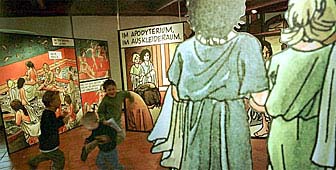Fumetto presents art of the comic strip

Lucerne is this week celebrating the 10th anniversary of Fumetto - an international festival which began life as a one-off project for the benefit of unemployed young people.
From this modest start it became an annual event, first as the Lucerne Comics Festival, then as the Swiss Comics Festival, before it eventually developed into an international celebration of the comic strip as an art form.
Fumetto is the Italian word for cigarette smoke, and in Italy is used to describe what the English-speaking world refers to as the “bubble” containing the words in cartoons.
One of the earliest comic strips dates back to the Bayeux Tapestry, a medieval depiction of the Battle of Hastings in 1066.
But a more recent ancestor of newspaper comic strips was the cartoon, especially popular in the late 19th century. For example, cartoons by William Hogarth regularly included bubbles – sometimes known as “balloons”.
The first strip with a regular cast of characters is believed to be “Max and Moritz” by Wilhelm Busch, while across the Atlantic, R.F. Outcault – born 1863 – introduced comic strips to the American public when he created the adventures of the Yellow Kid.
“It was because they mostly told adventure stories that they were more popular among young males than females,” says Sabine Witkowski, co-director of the Lucerne festival, who was over 30 when she herself discovered the world of comics. “Therefore comics were for a long time aimed exclusively at a male readership.”
But in recent years an increasing number of women have become comic artists, and this is reflected by their strong presence at Fumetto. The festival is this year dedicated to female comic artists, with Anke Feuchtenberger from Berlin as the guest of honour.
Witkowski says another comparatively recent development is that leading publishers are taking comics more seriously and publishing them in hardback form and making them available in general – and not only specialised – bookstores.
“The comic strip deserves to be taken seriously,” she told swissinfo. “It has aspects of literature and the movies as well as painting and drawing. That’s why it’s called graphic literature.”
That the strip cartoon can be a fully-fledged art form is clear from a tour of the festival locations scattered around the centre of Lucerne.
Fumetto closes on Sunday, but some exhibitions will last longer. In the meantime, throughout this week there will be discussions, films, multimedia spectacles and workshops for children within the framework of the festival.
by Richard Dawson

In compliance with the JTI standards
More: SWI swissinfo.ch certified by the Journalism Trust Initiative
You can find an overview of ongoing debates with our journalists here . Please join us!
If you want to start a conversation about a topic raised in this article or want to report factual errors, email us at english@swissinfo.ch.